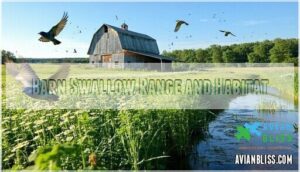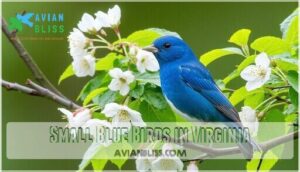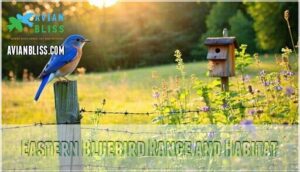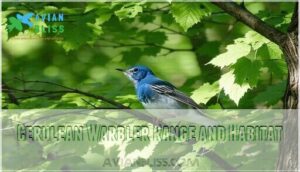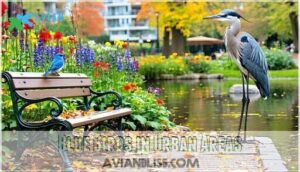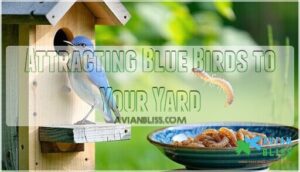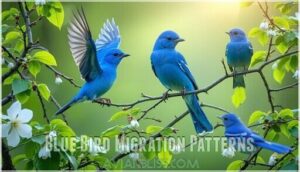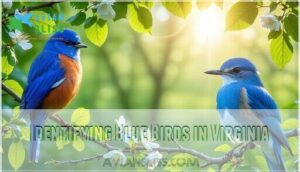This site is supported by our readers. We may earn a commission, at no cost to you, if you purchase through links.
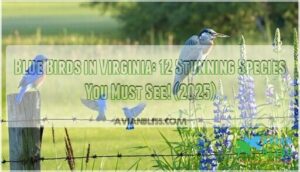 You’ll find twelve stunning blue birds in Virginia, ranging from the brilliant Eastern Bluebird to the majestic Great Blue Heron.
You’ll find twelve stunning blue birds in Virginia, ranging from the brilliant Eastern Bluebird to the majestic Great Blue Heron.
These azure beauties call Virginia home year-round or visit seasonally, each bringing unique characteristics to the Commonwealth’s diverse landscapes.
Blue Jays brighten your backyard with their intelligence and vibrant plumage, while tiny Indigo Buntings flash like sapphires through summer meadows.
Tree Swallows dance over water, Belted Kingfishers patrol streams, and Cerulean Warblers nest high in mature forests.
From coastal marshes to mountain peaks, you’ll discover species that thrive in specific habitats, each with distinct behaviors and identification features that make spotting them a rewarding challenge.
Table Of Contents
- Key Takeaways
- Blue Birds in Virginia Overview
- Common Blue Birds in Virginia
- Small Blue Birds in Virginia
- Large Blue Birds in Virginia
- Blue Birds With Unique Features
- Blue Birds in Urban Areas
- Attracting Blue Birds to Your Yard
- Blue Bird Migration Patterns
- Identifying Blue Birds in Virginia
- Frequently Asked Questions (FAQs)
- What does it mean when you see a lot of bluebirds in your yard?
- What are the tiny blue birds in Virginia?
- Why are Eastern Bluebirds good to have around your property?
- Are Eastern Bluebirds rare to see?
- What are the blue-colored birds in Virginia?
- Do Bluebirds live in Virginia?
- How many blue birds are there in Virginia?
- What is an eastern bluebird?
- How do blue birds communicate with each other?
- What threats do blue birds face in Virginia?
- Conclusion
Key Takeaways
- You’ll find over 15 species of blue birds in Virginia, ranging from tiny Indigo Buntings to massive Great Blue Herons, with each species thriving in specific habitats from coastal marshes to mountain forests.
- You can attract Eastern Bluebirds and Blue Jays to your yard by providing live mealworms, shallow water dishes, and properly positioned nest boxes with 1.5-inch entrance holes spaced 100 yards apart.
- You’ll spot year-round residents like Eastern Bluebirds and Blue Jays throughout winter, while seasonal migrants such as Indigo Buntings arrive in spring and depart by late fall for Central America.
- You can identify blue birds by noting their size, wing patterns, and color combinations—males typically display brighter blues than females, and each species has distinctive calls and habitat preferences.
Blue Birds in Virginia Overview
You’ll find Virginia’s diverse landscapes support over 15 species of blue-colored birds, ranging from the tiny Indigo Bunting to the impressive Great Blue Heron.
These species include year-round residents like the Eastern Bluebird and Blue Jay, as well as seasonal migrants that travel through the state during spring and fall migrations.
Types of Blue Birds in Virginia
Virginia hosts an impressive diversity of blue birds in virginia, featuring distinct color variations across species.
You’ll encounter the brilliant Eastern Bluebird with its signature orange chest, the bold Blue Jay displaying striking blue and black patterns, and the entirely blue Indigo Bunting.
Regional distribution varies, with some species showing plumage changes seasonally.
Uncommon species like the Cerulean Warbler add excitement to birdwatching adventures.
Occasional hybridization between closely related species creates unique observations for dedicated virginia bluebirds enthusiasts throughout the state.
Many species, such as the Indigo Bunting, display bright blue plumage.
Blue Bird Habitats and Characteristics
Blue birds in Virginia thrive across diverse ecosystems, from woodlands to suburban backyards.
Their habitat diversity supports various species like the eastern bluebird, which prefers open fields with scattered perches. Understanding these magnificent creatures enhances your birdwatching in Virginia experience through careful observation of their unique traits.
The Carolina Wren’s habitat often includes dense thickets.
- Plumage Variation: Males display brilliant blues while females show subdued earth tones for camouflage during nesting.
- Song Identification: Each species produces distinctive melodies that help with bluebird identification in the field.
- Social Behavior: Some gather in flocks while others remain territorial throughout breeding seasons.
Common Blue Birds in Virginia
You’ll encounter three common blue bird species throughout Virginia’s diverse landscapes, each adapted to specific habitats and displaying unique behavioral patterns.
These widespread species—the Blue Jay, Barn Swallow, and Belted Kingfisher—represent the most frequently observed blue-colored birds across the state’s woodlands, open areas, and waterways.
Blue Jay Range and Habitat
Blue Jays thrive across Virginia’s deciduous forests, particularly areas rich with oak and beech trees.
These year-round residents adapt well to suburban expansion, though habitat fragmentation poses challenges.
You’ll spot them in woodland edges, city parks, and backyard feeders where food availability remains high.
Blue Jays often favor areas with oaks and mast producing trees.
Climate change affects their bird range, but Virginia’s diverse bird habitats continue supporting healthy populations despite increasing nesting competition.
Barn Swallow Range and Habitat
After admiring Blue Jays, you’ll discover Barn Swallows showcasing remarkable adaptability across Virginia’s diverse landscapes.
These agile bird species utilize open habitats near water sources, where Swallow Foraging occurs over fields and marshes.
Their Nesting Preferences include human-made structures like barns and bridges, though Habitat Threats from development challenge their Virginia bird range.
- Graceful aerial maneuvers over farmlands
- Mud nest construction under protective eaves
- Long-distance migration covering 600 miles daily
Belted Kingfisher Range and Habitat
Belted Kingfishers establish territories near Virginia’s waterways, from Chesapeake Bay to mountain streams.
You’ll spot these skilled fishers along rivers, lakes, and quarries throughout the state.
Their fishing techniques involve dramatic dives from perches, while nesting behavior includes burrowing into earthen banks.
| Virginia Birdwatching Locations | Kingfisher Diet | Conservation Status |
|---|---|---|
| James River | Fish (90%) | Stable |
| Shenandoah Valley streams | Crayfish, frogs | Low concern |
| Coastal marshes | Small aquatic prey | Protected |
Small Blue Birds in Virginia
You’ll find Virginia’s small blue birds in diverse habitats, from forest edges to open woodlands, where species like the brilliant Indigo Bunting and sleek Tree Swallow showcase stunning azure plumage.
These compact birds, typically measuring 4-6 inches in length, demonstrate remarkable adaptability as they navigate between breeding grounds and wintering areas throughout the state’s varied ecosystems, including the stunning azure plumage they display.
Indigo Bunting Range and Habitat
Looking at these small songbirds, you’ll find Indigo Buntings across Virginia’s diverse landscapes.
Their breeding territories span from southeastern Canada to the Gulf Coast, with Virginia sitting perfectly within this range.
These brilliant blue birds prefer specific habitat preferences that make spotting them predictable.
During summer months, you’ll discover them in:
- Weedy fields between woodlands and open areas
- Shrubby swamps with dense vegetation
- Forest edges near cultivated farmland
- Roadside thickets and overgrown fence rows
- Mesic forests with scattered clearings
Their migration routes stretch approximately 1,200 miles to wintering grounds in Central America, making Virginia a vital stopover point for these stunning blue birds in Virginia.
Tree Swallow Range and Habitat
Spotting Tree Swallows around Virginia’s wetlands reveals their remarkable habitat preferences.
These acrobatic birds depend on open areas near water, from marshes to lakeshores. Their bluebird habitat needs differ substantially from forest-dwelling species.
- Wetland Dependence—require water sources for insect abundance and nesting opportunities
- Swallow Nesting—utilize tree cavities or nest boxes within 60 km of water
- Migration Patterns—arrive early spring, winter in southern regions
- Habitat Loss—conservation efforts protect essential breeding grounds
Black-throated Blue Warbler Range and Habitat
Black-throated Blue Warblers thrive in Virginia’s northeastern mountains during breeding habitats season.
These bird species prefer undisturbed deciduous forests with dense understory shrubs.
Winter range extends to Caribbean islands and southern Florida.
Forest dependence makes them vulnerable to habitat fragmentation.
Their conservation status remains stable, but birdwatching enthusiasts should protect Virginia’s mature bird habitat for future generations.
Large Blue Birds in Virginia
You’ll encounter Virginia’s most impressive blue birds in wetland areas, where Great Blue Herons and Little Blue Herons showcase their remarkable size and hunting skills.
These wading birds, with their distinctive blue-gray plumage and long legs, frequent marshes, ponds, and slow-moving streams throughout the state.
Offering spectacular viewing opportunities for patient observers is a key aspect of observing these birds in their natural habitat, with their remarkable size and hunting skills.
Little Blue Heron Range and Habitat
You’ll find Little Blue Herons across Virginia’s diverse wetlands, from coastal marshes to inland swamps.
These striking blue birds in virginia depend on shallow water habitats where prey abundance supports their patient hunting style.
Their coastal distribution extends throughout the state’s bird habitats, with juveniles particularly drawn to protected wetland areas despite ongoing conservation challenges.
- Freshwater marshes and river swamps
- Saltwater estuaries and tidal creeks
- Shallow ponds with emergent vegetation
- Brackish wetlands near the coast
Great Blue Heron Range and Habitat
Great Blue Herons thrive throughout Virginia’s coastal habitats and freshwater wetlands, demonstrating remarkable wetland dependence.
You’ll find these magnificent birds year-round in the Chesapeake Bay region, where their foraging ecology centers on shallow water fishing.
They establish nesting colonies called rookeries in tall trees near water sources.
Their stable conservation status reflects successful Virginia wildlife protection efforts.
Blue Birds With Unique Features
You’ll discover that Virginia’s most distinctive blue birds possess remarkable features that set them apart from their common relatives.
The Blue Grosbeak’s massive seed-cracking beak, the Eastern Bluebird’s vibrant orange breast contrasting with azure wings, and the Cerulean Warbler’s distinctive white wing bars create identification opportunities that reward careful observation.
Blue Grosbeak Range and Habitat
Blue Grosbeaks establish breeding territories across Virginia’s shrubby landscapes, making them one of the most striking blue birds in Virginia.
These robust bird species prefer specific habitat preferences that support their unique lifestyle.
You’ll find Blue Grosbeaks thriving in these Virginia environments:
- Overgrown fields with scattered bushes and fence rows
- Forest edges where woodlands meet open areas
- Stream corridors with dense shrub growth
- Abandoned farmland reverting to natural bird habitat
Their diet variations include insects during breeding season and seeds year-round.
Migration patterns bring them north from Central America each spring, while their conservation status remains stable throughout their range.
Eastern Bluebird Range and Habitat
Where do eastern bluebirds thrive best in Virginia? These stunning blue birds in virginia prefer open woodlands, meadows, and farmlands with scattered perches.
Their bluebird habitat includes golf courses and cemeteries where they hunt insects from fence posts.
| Habitat Feature | Preference | Distance |
|---|---|---|
| Territory Size | 2-8 acres | Individual pairs |
| Nest Box Placement | Open areas | 100+ yards apart |
| Winter Roosting | Tree cavities | Communal groups |
| Open Area Needs | 50% coverage | Hunting grounds |
Their bluebird range spans Virginia’s diverse landscapes year-round.
Cerulean Warbler Range and Habitat
High in Virginia’s forest canopy, Cerulean Warblers claim their breeding grounds among towering oaks and maples.
Amidst Virginia’s towering canopies, the elusive Cerulean Warbler stakes its claim in nature’s penthouse suite.
These sky-blue gems face serious habitat loss threats, earning them a concerning conservation status. Their migratory routes stretch from Appalachian peaks to South American mountains, making Virginia bird habitats essential stopover points. Hybridization is a threat to related species.
You’ll spot them in three key locations:
- Mature deciduous forests with 80+ foot canopies
- Riparian woodlands along mountain streams
- Mixed hardwood stands on steep hillsides
Blue Birds in Urban Areas
You’ll find several blue bird species thriving in Virginia’s urban environments, including Blue Jays in suburban neighborhoods and Barn Swallows nesting under city bridges and building overhangs.
These adaptable birds have learned to navigate concrete landscapes, with species like Indigo Buntings frequenting weedy gardens and parks while Great Blue Herons hunt along urban waterways and retention ponds, showcasing their ability to thrive in various urban environments.
Blue Birds in Virginia Suburbs
Virginia’s suburban landscapes create perfect havens for blue birds, especially Eastern Bluebirds seeking Suburban Nesting opportunities.
These charming neighborhoods offer ideal Virginia bird habitats with their mix of open lawns and scattered trees. Population Density remains manageable here, allowing blue birds to thrive while adapting to human presence through remarkable Urban Adaptation.
You’ll find attracting bluebirds easier by installing bluebird houses on fence posts. Their Feeder Preferences include mealworms and sunflower seeds at backyard stations.
However, Suburban Threats like cats and window strikes require your attention when creating bird-friendly spaces.
Blue Birds in Virginia Cities
City parks and downtown green spaces become unexpected havens for Virginia’s blue bird species.
Urban Habitats challenge these feathered residents, yet many Eastern Bluebird and Blue Jay populations show remarkable Adaptation Strategies. Population Density doesn’t deter their survival—they’ve learned to navigate traffic noise and find nesting spots in surprising places.
City Conservation efforts through native plantings and reduced window strikes help maintain Bird Diversity for dedicated birdwatching enthusiasts.
Bird conservation in urban Virginia creates hope through:
- Community nest box programs
- Native plant gardens in city centers
- Reduced light pollution initiatives
Attracting Blue Birds to Your Yard
Creating the perfect habitat for blue birds requires understanding their specific needs for food, water, and nesting sites in your outdoor space.
You can successfully attract species like Eastern Bluebirds and Blue Jays by providing live mealworms, fresh water sources, and properly positioned nest boxes with entrance holes measuring 1.5 inches in diameter, which is crucial for attracting species and creating a suitable environment with live mealworms.
Food and Water for Blue Birds
Bringing bluebirds from urban areas to your backyard starts with understanding their bluebird diet.
These birds thrive on insect diets during summer months, making attracting bluebirds easier when you offer live mealworms in specialized bluebird feeders.
Water availability proves equally important—shallow dishes work best.
You can buy live mealworms online for bird feeding.
Winter feeding requires different feeder types with berry sources like elderberries and sumac.
Bird feeding success depends on consistent offerings, and proper bird feeders positioned in open areas create the perfect dining experience for these beautiful visitors.
- Live mealworms in summer – Essential protein source for breeding pairs
- Fresh berries in winter – Natural energy when insects become scarce
- Shallow water dishes – Clean drinking sources attract more species
Nesting Sites for Blue Birds
Transforming your yard into a bluebird haven starts with nest box design that mimics natural cavities.
Mount boxes on poles with predator protection like baffles, positioning them in open areas away from dense vegetation.
Proper site selection matters—space boxes 100 yards apart to reduce competition.
Eastern Bluebirds prefer bird nesting sites in fields and golf courses.
Consider nest box options for ideal bird housing.
Add nesting materials like pine needles nearby to support their nesting habits and encourage successful bird nesting.
Blue Bird Migration Patterns
You’ll notice that Virginia’s blue birds follow distinct migration patterns, with some species like Indigo Buntings traveling thousands of miles to Central and South America each winter, while others such as Eastern Bluebirds and Blue Jays remain in the state year-round due to the mild climate.
Understanding these seasonal movements helps you predict when to expect different species in your backyard, as migratory birds typically arrive in Virginia during spring breeding season and depart by late fall.
Seasonal Migration of Blue Birds
When autumn arrives, bluebird migration begins as Migration Triggers like shorter daylight and cooler temperatures signal departure time.
You’ll witness fascinating bird migration patterns as these travelers seek Winter Habitats in warmer southern regions.
Virginia bird migration patterns reveal remarkable journeys:
- Spring Arrival occurs between March and April
- Migration Routes follow major flyways southward
- Breeding Impact influences timing and destinations
- Weather conditions affect bird migration success rates
Year-Round Residents in Virginia
Several blue birds in virginia have adapted remarkably well to the state’s climate, choosing to remain year-round rather than migrate.
These hardy Virginia bird species demonstrate impressive Climate Adaptation strategies that allow them to thrive through winter months.
Eastern Bluebirds represent the most successful year-round residents, with stable populations benefiting from extensive Habitat Preservation efforts.
Their Winter Diet shifts from insects to berries, suet, and seeds you provide at feeders.
Blue Jays also stick around, caching food like nature’s preppers and raiding your sunflower seed supplies with amusing persistence.
These permanent residents maintain their Breeding Habits and territories throughout the year, contributing to Population Stability across Virginia nature reserves.
When you’re birdwatching during winter months, you’ll spot these faithful companions huddled in protected habitat areas, proving that some birds truly call Virginia home.
Identifying Blue Birds in Virginia
When you’re trying to identify blue birds in Virginia, you’ll need to pay attention to specific features like size, wing patterns, and breast coloration, since these birds range from the tiny Indigo Bunting to the large Great Blue Heron.
Start by noting whether the bird is entirely blue, has blue mixed with other colors, or shows blue only on certain body parts, as this distinction will help you narrow down the species quickly, considering the variety of birds, from the tiny Indigo Bunting to the large Great Blue Heron.
Tips for Identifying Blue Birds
Successful bird identification requires understanding what makes each species unique. Blue birds in virginia offer distinct characteristics that help separate one from another. These birdwatching tips will sharpen your identification skills during your next outdoor adventure.
Focus on these key identification markers:
- Plumage variations: Males typically display brighter blues than females, with seasonal changes affecting intensity and patterns throughout the year.
- Song identification: Each species produces unique calls – Eastern Bluebirds offer soft warbles while Blue Jays create harsh, varied vocalizations.
- Habitat clues: Open fields suggest Eastern Bluebirds, while dense woodlands indicate Blue Jays or warblers.
- Behavior patterns: Watch feeding habits, flight styles, and social interactions to distinguish between similar-looking species.
To further enhance your observations, consider adding native plants to attract a wider variety of birds. These bird identification guides will transform your birdwatching experience into successful encounters.
Blue Bird Size and Shape
Identifying blue birds in virginia requires understanding their distinct body proportions and plumage variation. Eastern bluebird males display vibrant blue plumage with orange breasts, measuring 6.3-8.3 inches in length.
Wing shape varies between species—some have pointed wings for swift flight, others rounded for maneuverability. Tail length differs too; some species sport short, squared tails while others feature longer, forked designs.
Beak morphology also aids bird identification and bird appearance assessment. You can find bird-related products here.
Frequently Asked Questions (FAQs)
What does it mean when you see a lot of bluebirds in your yard?
When nature blesses you with frequent bluebird visitors, you’re witnessing a thriving ecosystem.
Your yard likely offers excellent habitat—open spaces, insect-rich areas, and nesting opportunities.
It’s their stamp of approval on your environmental stewardship.
What are the tiny blue birds in Virginia?
You’ll spot Indigo Buntings most often – they’re Virginia’s smallest blue birds at just 5 inches long.
Males shine brilliant blue during breeding season, while females appear brownish with subtle blue hints on wings and tail, showcasing a notable difference in breeding season appearances.
Why are Eastern Bluebirds good to have around your property?
Eastern Bluebirds are natural pest controllers, devouring thousands of harmful insects like crickets, caterpillars, and beetles that damage your garden.
They’ll keep your yard healthier while adding beautiful blue flashes of color to your landscape.
Are Eastern Bluebirds rare to see?
Like spotting a friend in a crowd, you’ll find Eastern Bluebirds aren’t rare in Virginia’s open fields and backyards.
They’re year-round residents with stable populations, thanks to successful conservation efforts and widespread nest box programs.
What are the blue-colored birds in Virginia?
You’ll encounter about 15 blue-colored bird species in Virginia, including the brilliant Indigo Bunting, iconic Blue Jay with its crested head.
The charming Eastern Bluebird with orange chest, and Blue Grosbeak with its distinctive thick beak are also part of this group.
Do Bluebirds live in Virginia?
Yes, Eastern Bluebirds thrive year-round in Virginia’s mild climate.
You’ll find these small, vibrant birds with bright blue backs and orange chests in open fields, backyards, and golf courses throughout the state.
How many blue birds are there in Virginia?
Virginia hosts over 15 species of blue-colored birds, including year-round residents like Eastern Bluebirds and Blue Jays.
Plus seasonal visitors such as Indigo Buntings and various warblers that migrate through the state.
What is an eastern bluebird?
An Eastern Bluebird’s a small songbird you’ll recognize by its brilliant blue back and rusty-orange breast.
These cavity nesters love open fields, feeding mainly on insects while perching gracefully on fence posts.
How do blue birds communicate with each other?
Like feathered chatterboxes at a neighborhood barbecue, blue birds use songs, calls, and body language to communicate.
You’ll hear males singing to claim territory, couples chatting softly, and alarm calls warning of danger nearby.
What threats do blue birds face in Virginia?
Habitat loss from development, pesticide use, and invasive species threaten you’ll observe fewer blue birds.
Climate change alters migration patterns, while window collisions and predators like cats pose additional risks to Virginia’s vulnerable populations, including the threat of habitat loss.
Conclusion
Remarkably, Virginia hosts over 400 bird species, with blue birds representing some of the most enchanting varieties you’ll encounter.
These twelve stunning blue birds in Virginia offer endless opportunities for observation and photography throughout the year.
Whether you’re tracking seasonal migrations or establishing backyard habitats, each species provides unique behavioral insights and identification challenges.
From coastal wetlands to mountain forests, Virginia’s diverse ecosystems support these azure beauties year-round.
Start your birding journey today and discover these magnificent creatures.
- https://www.fws.gov/refuge/chincoteague
- https://www.facebook.com/shenandoahnps/photos/a.368275649864529/6599687466723285/
- https://www.pilotonline.com/life/wildlife-nature/article_b3d0bc79-8e81-5a8b-b6c9-58ecf7a266e2.html
- https://static1.squarespace.com/static/60048f2f4616fd2204d63be8/t/60d634c7fc8fbb2f08971a30/1624650951527/Carl_Little_Nest_Box_Plans_20210425.pdf
- https://www.virginiabluebirds.org/


